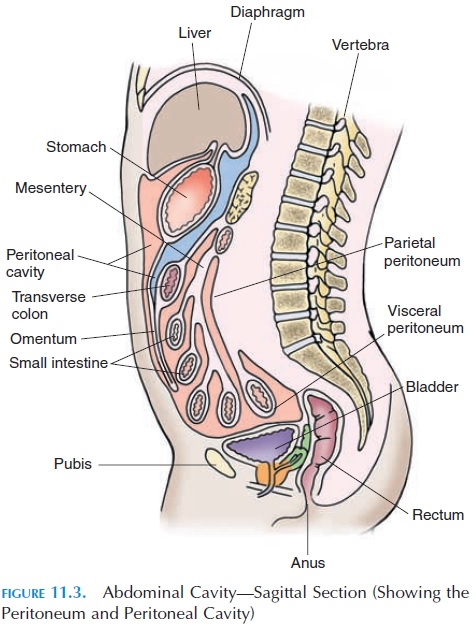Chapter: The Massage Connection ANATOMY AND PHYSIOLOGY : Digestive System
Peritoneum
Peritoneum
The peritoneum (see Figure 11.3) is the serous membrane that lines the abdominal cavity. It has a smooth inner lining (simple squamous epithelium) supported by connective tissue. This membrane secretes the peritoneal fluid, a clear fluid that lubricates the in-side of the abdominal cavity packed with various or-gans. The peritoneum secretes and absorbs about 7 liters (7.4 qt) of fluid every day.

The best way to describe the way the peritoneum covers the abdominal organs is by analogy. If you tried to push your hand into a partially filled balloon, your fist would be closely covered by one layer of bal-loon and separated from the other layer by air. This is similar to how the peritoneum covers the organs. The layer close to the organ (your fist) is the visceralperitoneum, and the layer away from the organ (theouter layer) is the parietal peritoneum. The parietal peritoneum lines the inside of the abdominal cavity. The cavity between the two layers of peritoneum con-taining serous fluid is the peritoneal cavity.
MESENTERY AND OMENTUM
To visualize how the intestine is held in place, imag-ine that, instead of your fist, you held a pencil side- ways (i.e., the length of the pencil) and pushed into the partially filled balloon. When the pencil is pushed halfway into the balloon and the inner layer of the balloon covers the pencil, two layers are formed be-fore it continues as the outer layer (see Figure 11.4). Alternately, if you covered a pencil on a table with a piece of tissue paper and then lifted the pencil off the table with two fingers (the pencil still covered with tissue paper), you will find that the tissue paper falls as two layers to the sides of the pencil after covering the pencil. This is how most of the small intestines are covered by peritoneum (the tissue is equivalent to the peritoneum and the pencil to the intestine).

The two layers of peritoneum are close to each other after they cover the intestine and before they continue as the parietal peritoneum lining the abdom-inal wall. The two layers together form a sheet known as the mesentery (Figure 11.3). In this way, the small intestines are positioned in the abdomen and attached to the abdominal wall. The mesentery also prevents the lengthy small intestine from getting entangled. Blood vessels and nerves access the intestine by pass-ing between the two layers of the mesentery.
In addition to the mesentery that holds the small intestine in place, another sheet of modified mesen-tery falls like an apron from the stomach superiorly, over the anterior aspect of the abdominal cavity. This is known as the omentum. The omentum contains a lot of adipose tissue and helps pad and protect the ab-dominal organs and prevents rapid heat loss from the anterior aspect of the abdomen.
Structures located posterior to the peritoneum (i.e., in the posterior abdominal wall covered anteri-orly by parietal peritoneum) are said to be retroperi-toneal.Retroperitoneal organs include the kidneys,adrenal glands, and pancreas.
Related Topics